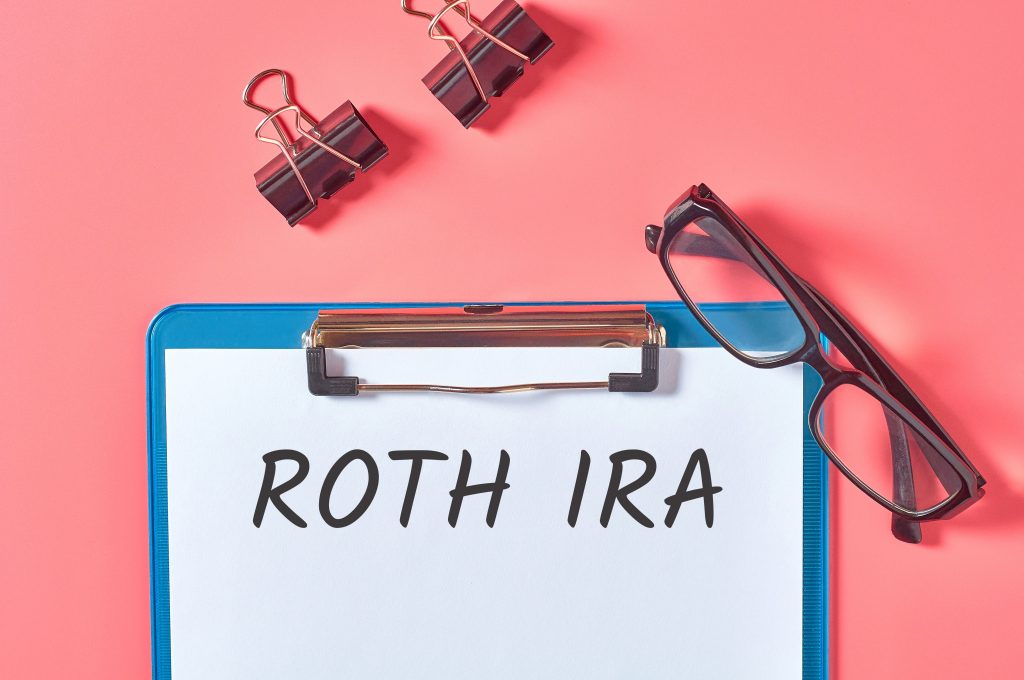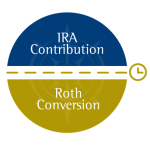
How to Contribute Money to a Roth IRA Even if You Have a High Income
Here’s a simple plan that may help any person go tax free with a Roth, regardless of income. Plus, there is a hidden benefit for older folks and people with a higher income. So let’s dive in.
Similar to a back-door Roth conversion, but better
You may have heard of the back-door Roth Conversion which is a horrible name, for reasons I’ll discuss below. So instead of that name, we’re going to call it the “Any Wealthy-Person’s Roth Contribution.” Does it only work for the wealthy? Of course not! But it is particularly good for folks who will live a long time, and wealthy women tend to have longlives!
Let’s talk about how it works. This diagram shows the process pretty clearly. You may do either or both parts, and each one is a different financial planning consideration.
Part 1. Make an IRA contribution (even if it’s not deductible)
To make an IRA contribution, you (or your spouse) need to have earned income. If you don’t have earned income, but only have passive income, or portfolio income, then you cannot pass step 1.
In the year 2024, you may contribute up to the lesser of your earned income or $7,000 if you’re under age 50. You may contribute $8,000 if you’re age 50+. You may contribute this amount per person, per year. For the most recent contribution limits, refer to Go Tax Free Resources.
Regardless of income, you may make this contribution to a tax-deferred IRA. It might not be tax-deductible, but you may still make the contribution as long as you have earned income equal to or in excess of the annual limits. It does not matter if you or your spouse has a 401k at work, you may still contribute to a tax-deferred IRA.
If your income exceeds the limits in Go Tax Free Resources for this year, then your contribution is not deductible. You must track your contribution amount for however long you’re going to own the deferred IRA. See further, below.
How to double the annual IRA contribution
If you are married, you may make this contribution for each of you, each into your own IRA. In 2024, if you are at least 50, you’ve got a $16,000 contribution. For the latest updates for this year’s contribution limits, refer to Go Tax Free Resources.
How to quadruple the annual IRA contribution
Even if you are not married, you can double your contribution if you are a procrastinator with your taxes. You need three things.
- First, earned income both last year and this year.
- Second, in both years that earned income equaled or exceeded the maximum contribution limits.
- Third, you need to have not yet paid your taxes for last year.
You’ll write two checks to your IRA custodian. One check with a memo line, “Last year’s IRA contribution” and the other check with “This year’s IRA contribution.” If you’re married, you’ve quadrupled your IRA contribution. And you don’t really have to use a check–you can electronically transfer the money–but the image of the check is important, you see, to show how easy it is to double–or quadruple–your IRA contribution, even if it is not tax-deductible.
To re-iterate, step 1 of the Any Wealthy-Person’s Roth Contribution plan is to make a contribution to an IRA regardless of your age and regardless of your income.
But, you say, I thought I couldn’t contribute because my income was too high?
Deductible IRA income contribution limits
If you want your contribution to be a tax-deduction, then you’re subject to the income limits. Check out the most recent deductible income limits in Go Tax Free Resources.
Although the limits are low, you do not need a tax-deduction for this tax-saving plan to work. The income limit is not relevant to our plan here. We want at least tax-deferral and/or to go tax free. Anyone with earned income may contribute to an IRA. After the SECURE ACT of 2019, anyone of any age may contribute to an IRA.
Part 2: Convert to a Roth IRA
Convert your IRA to a Roth IRA is the second step. Conversion is easy to do. You tell your wealth manager to do it, they ask you to sign a form, and it takes place in the year you sign the document. If you are converting a (deductible IRA) retirement account, you have not yet paid taxes on the money in the account. Thus you are going to have income taxes due on every dollar of the conversion. However, if you have a (non-deductible IRA) retirement account with a tax-basis, then you only pay taxes on the gains. See below: “Caveat 1: aggregation rule.”
The Any Wealthy-Person’s Roth Contribution plan is as simple as that. But the two caveats that follow are important, and they are where you’re going to want to talk with your wealth manager.
Caveat 1: IRA aggregation rule
If, because of your income limits, you’re planning on making a non-deductible IRA contribution, then you need to understand the aggregation rule. The IRS makes you treat all of your IRAs as if they are one IRA. This is spelled out in IRC Section 408(d)(2).
So if you have a mixture of IRA accounts without cost basis along with your newly-created non-deductible IRA, you’re going to add up all their values, divide the small number by the big number, and pay taxes on the inverse of that percentage.
| cost basis in the non-deductible IRA | = | % tax-free on the Roth conversion |
All your IRAs count in the aggregation rule. To figure out your tax liability, take the inverse of that percentage: one minus the percentage. The following example walks through a $10,000 Roth conversion for a family who has 90% of their assets in tax-deferred IRAs and who are in the 12% marginal tax bracket.
| % Taxable | 90% | x |
| Roth conversion $ | $10,000 | x |
| marginal income tax rate | 12% | = |
| tax liability | $1,080 |
Workaround for Caveat #1
Move your IRAs into a Solo 401k. The 401k plan is not part of the aggregation rule. Then, convert the remaining IRA. If the only IRA remaining is the (non-deductible IRA) retirement account with cost basis, then you’ve no tax liability other than the taxes on the growth.
Note, the aggregation rule doesn’t look at your spouse’s IRA accounts. They could have any combination of tax-deferred and tax-free investments over there and it won’t affect your plan at all. Again, the aggregation rule only looks at IRA accounts, which means a Simple IRA or SEP IRA are aggregated but a 401k is not.
Caveat 2: Take your time and invest
 Don’t rush the Any Wealthy-Person’s Roth Contribution plan or you may end up in an IRS audit. The IRS has something called the step transaction doctrine which may, or may not, be relevant to your situation. But you don’t want to cause trouble, so steer clear. An unpleasant excess contribution penalty tax is, in 2023, a 6% penalty tax. The possibility of unnecessary stress is is the main reason you don’t call this a back door Roth Contribution.
Don’t rush the Any Wealthy-Person’s Roth Contribution plan or you may end up in an IRS audit. The IRS has something called the step transaction doctrine which may, or may not, be relevant to your situation. But you don’t want to cause trouble, so steer clear. An unpleasant excess contribution penalty tax is, in 2023, a 6% penalty tax. The possibility of unnecessary stress is is the main reason you don’t call this a back door Roth Contribution.
Here are two good ways to avoid this possible, albeit unlikely, problem. Take your time and invest.
Take your time
Take your time after you make a non-deductible contribution and before you make the Roth conversion. How much time should you take? This is up to you. Some experts recommend that “one statement period” is long enough. Others say that one year and a day is long enough. They may be right. Because we’re more conservative, we’re usually allowing two tax years to pass before we consider Roth conversions here at AIWM. This seems to be safe. It’s well thought out. There is plenty of time for you to change your mind. It’s defensible that when you made your after-tax IRA contribution you intended to keep it tax-deferred forever. And, who knows? Maybe you’ll do that and keep it tax-deferred and track your cost basis.
Keep investing
My second recommendation is to invest the money in the mean time. However long you and your wealth manager determine it to be suitable for your situation, you’ll want to invest that money in a manner that is appropriate for you. If you lose money, you won’t be able to take a tax loss (because it’s in an IRA now). If your investment grows, and in the future you decide to do a Roth conversion, then you’ll pay taxes on the growth (only the amount above your initial investment). In other words, the growth is taxable in a traditional IRA funded with after-tax dollars. But in a Roth IRA, it’s all tax free. And like we discussed, you’ll want to be careful with the IRA aggregation rules.
One final note, don’t call this a back-door Roth Contribution. Why would you invite trouble and stress? Each step of this plan lives on it’s own. They are each defensible and tax-smart.
Summary
Any Wealthy-Person’s Roth Contribution plan enables anyone with earned income of any age to take otherwise taxed-as-earned money and turn it into tax-free money, but not right away. You’ll make at least two decisions separated over a time that you and your wealth manager deem appropriate for your unique financial plan.
 Help Center
Help Center












